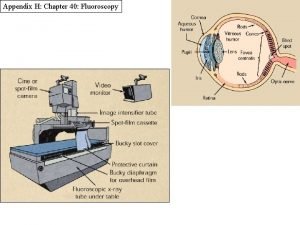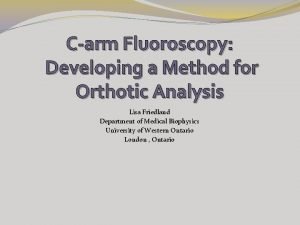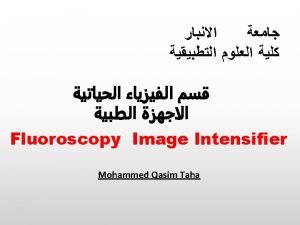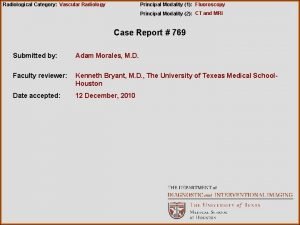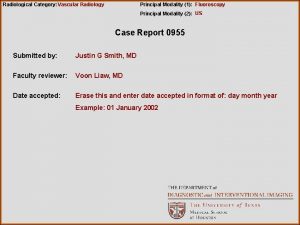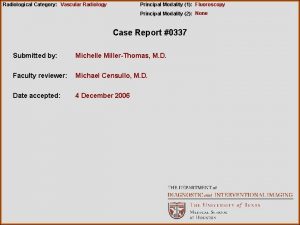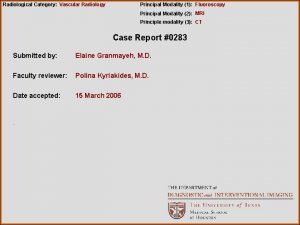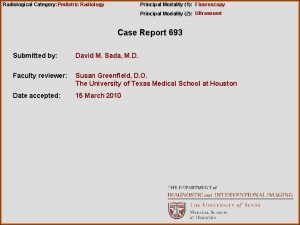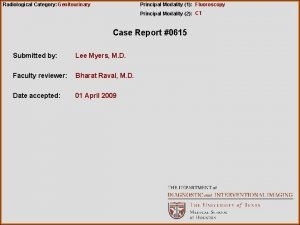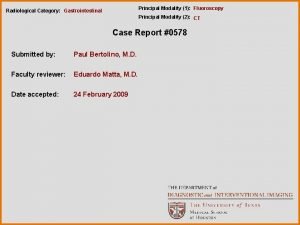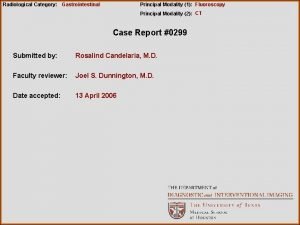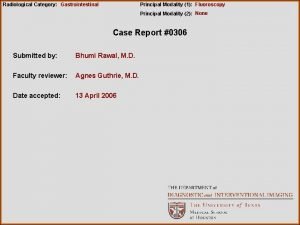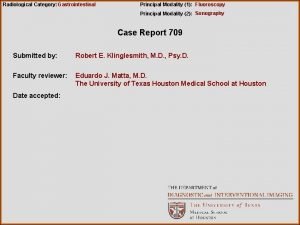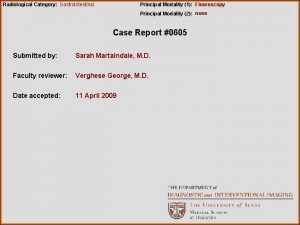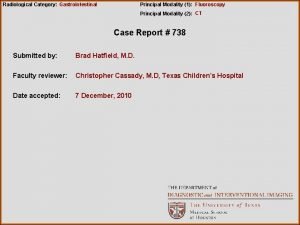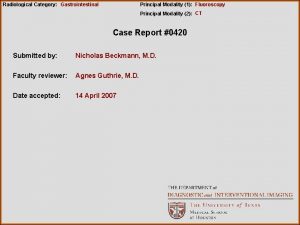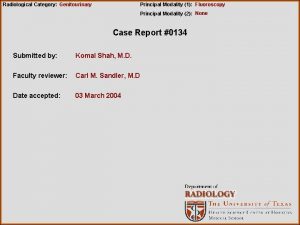Radiological Category Vascular Radiology Principal Modality 1 Fluoroscopy















- Slides: 15

Radiological Category: Vascular Radiology Principal Modality (1): Fluoroscopy Principal Modality (2): CT Case Report # 795 Submitted by: Lori Sedrak, D. O. Faculty reviewer: Alan Cohen, M. D. , The University of Texas Medical School at Houston Date accepted: 17 January, 2011

Case History 40 year-old male presenting with hematuria.

Case History Other significant history currently withheld.

Radiological Presentations Axial contrast enhanced CT

Radiological Presentations Coronal contrast enhanced CT

Radiological Presentations Selective Digital Subtraction Angiography

Test Your Diagnosis Which one of the following is your choice for the appropriate diagnosis? After your selection, go to next page. • Renal Cell Carcinoma (RCC) • Angiomyolipoma (AML) • Arterial-Venous Malformation (AVM)

Findings and Differentials Findings: CT: Bilateral renal cysts with a 8. 3 x 5. 9 cm irregular enhancing left renal lesion with cystic components and extension into the parapelvic region. A small amount of fat attenuation is identified. DSA: Selective catheterization of the left renal artery demonstrating increased arterial flow to the hypervascular inferior renal lesion with 2 cm saccular aneurysm formation. Differentials: • AML • RCC • AVM

Discussion Renal Cell Carcinoma (RCC)- Malignant neoplasm from tubular epithelium that usually presents as a hypervascular solid renal mass. RCC rarely contains macroscopic fat, however fat and calcifications may be seen in a dedifferentiated RCC. Multifocal RCC can be seen in patients with von-Hippel-Lindau (VHL) disease. Image provided by Dr. Michael Redwine.

Discussion Arterial-Venous Malformation (AVM) – Vascular malformation consisting of fistulous communication between an artery and vein. Demonstrates classic ‘yinyang’ appearance on Doppler ultrasound.

Discussion Example of Arterial-Venous Malformation one year following renal biopsy of a left lower quadrant transplant kidney. Occlusion can be achieved with GDC coils, as in this case.

Discussion Angiomyolipoma is a benign renal tumor arising from vascularity, adipose tissue and smooth muscle. In the absence of calcification, macroscopic fat is nearly diagnostic. Abnormal vascularity and aneurysm formation lead to an increased hemorrhagic risk with size >4 cm, therefore necessitating intervention. Risk of aneurysm rupture expectantly increases with increasing aneurysm size. Multiple, bilateral AML lesions are associated with Tuberus Sclerosis. Absolute ethanol serves a sclerosing agent with renal vascular malformation occlusion due to the thin liquid physical characteristics and high occlusive potential. Ethanol may also be combined with polyvinyl alcohol and iodinated contrast material to aid in occlusion and visualization, respectively. Mechanisms of ethanol occlusion include small arterial spasm, perivascular necrosis, endothelial damage and general sludging of red blood cells. When injected at a slow rate of 0. 1 ml/s damaged red cells and denatured protein result in occlusion. Average doses for single infusions are approximately 2 ml in an interlobar branch and 3 ml in a segmental branch.

Diagnosis Angiomyolipoma in a patient with a history of Tuberous Sclerosis. Hematuria and size criteria warranted intervention. Successful selective alcohol ablation of the hypervasucular supply to the left inferior renal lesion.

Radiological Presentations DSA post Et. OH ablation with preservation of the left upper renal pole vascularity.

References 1. O’brien, W. T. Top 3 Differentials in Radiology. New York, NY: Thieme, 2010: 106 -151. 2. Kandarpa, K. , Machan, L. (2011) Handbook of Interventional Radiologic Procedures. Philadelphia, PA: Lippincott Williams & Wilkins a Wolters Kluwer business. 3. Takebayashi S, Horikawa A, Arai M, Iso S, Noguchi K. Transarterial ablation for sporadic and non-hemorrhaging angiomyolipoma in the kidney. EJR 2009; 72: 139 -145. 4. Nelson CP, Sanda MG. Contemporary diagnosis and management of renal angiomyolipoma. J Urol 2002; 168: 1315– 25. 5. Yamakado K, Tanaka N, Nakagawa T, Kobayashi S, Yanagawa M, Takeda K. Renal angiomyolipoma: relationships between tumor size, aneurysm formation, and rupture. Radiology 2002; 225: 78– 82 Special gratitude is extended to Dr. Michael Redwine for assistance in providing differential diagnosis imaging.
 Digital fluoroscopy vs conventional fluoroscopy
Digital fluoroscopy vs conventional fluoroscopy Vascular and non vascular difference
Vascular and non vascular difference Non vascular vs vascular plants
Non vascular vs vascular plants Life cycle of seedless plants
Life cycle of seedless plants Pa erate
Pa erate National radiological emergency preparedness conference
National radiological emergency preparedness conference Radiological dispersal device
Radiological dispersal device Tennessee division of radiological health
Tennessee division of radiological health Center for devices and radiological health
Center for devices and radiological health Bronchoscopy fluoroscopy
Bronchoscopy fluoroscopy Spot film device fluoroscopy
Spot film device fluoroscopy Carm fluoroscopy
Carm fluoroscopy Optical coupling in fluoroscopy
Optical coupling in fluoroscopy Deontic modality
Deontic modality One to many relationship line
One to many relationship line Modality statistics
Modality statistics










